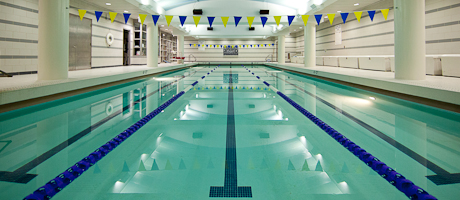When graduate student Lauren Hidalgo signed up for a half marathon a few months ago, she began swimming two to three times a week at the Lerner Health and Wellness Center as a way to cross-train.
She liked the low-impact benefits of swimming and thought it would be a good supplement to her training runs. But she wasn’t crazy about how her skin or hair felt after stepping out of the pool.
Thanks to the Health and Wellness Center’s new pool filtration system, that isn’t a problem anymore.
Last month, the center installed a salt chlorination system, replacing the need for liquid chlorine.
“We would have a company come in and deliver a vat of liquid chlorine, which would sit in our pump room. It wasn’t that safe, and it had a high chemical content,” said Meredith Dalenburg, assistant director of aquatics/safety and special events.
Traditional chlorine produces a unique smell that Ms. Hidalgo calls “nauseating.” The chemical also dries out swimmers’ skin and hair. A salt chlorination system, however, is less irritating to the body.
“It’s definitely easier on your skin,” said Ms. Hidalgo, who is pursuing a Master of Public Health in physical activity in the School of Public Health and Health Services. “You don’t feel as dried up in that stiff kind of way chlorine feels.”
While the new system still uses chlorine, it uses much less. Instead of having to directly add chlorine, the system automatically adds it when needed by breaking down salt. This not only reduces costs for the Health and Wellness Center, but it’s also eco-friendly because liquid chlorine no longer has to be transported back and forth to the center’s pool.
“It helps to decrease our carbon footprint, and it’s also a great example of a department on campus thinking about sustainability when making operational decisions,” said Sophie Waskow, sustainability project facilitator in GW’s Office of Sustainability. “We’re no longer relying on chemicals that are potentially damaging to people’s health and the environment.”
Because the system only uses about 3,500 parts per million of salt – compared with about 35,000 parts per million in the ocean – swimmers at the Health and Wellness Center won’t be overwhelmed by the salt content in the water.
“There’s a hint of salt, but it’s nothing like the ocean,” said Ms. Hidalgo. “The pool water is a lot clearer. You can see straight to the bottom.”


